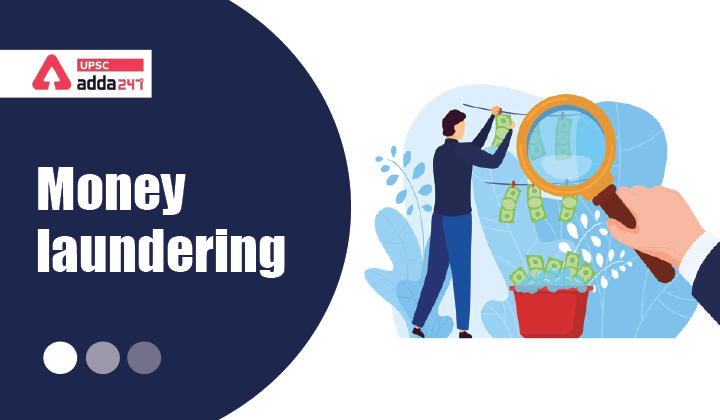Table of Contents
Money Laundering Explained: Relevance
- GS 3: Money-laundering and its prevention.
Money laundering meaning
- According to UN, “the conversion or transfer of property, knowing that such property is derived from any offense(s), for the purpose of concealing or disguising the illicit origin of the property or of assisting any person who is involved in such offense(s) to evade the legal consequences of his actions”.
- So, Money laundering can be defined as the illegal process of making large amounts of money generated by a criminal activity, such as drug trafficking or terrorist funding, appear to have come from a legitimate source.
- The money from the criminal activity is considered dirty, and the process “launders” it to make it look clean.
- Money laundering is a serious financial crime that is employed by white collar and street-level criminals alike.
Money Laundering 3 stages
- Placement: moving the funds from direct association with the crime.
- Layering: disguising the trail to foil pursuit.
- Integration: making the money available to the criminal from what seem to be legitimate sources.
How much money is laundered in the world?
- According to UN, the estimated amount of money laundered globally in one year is 2 – 5% of global GDP, or $800 billion – $2 trillion in current US dollars.
- Due to the clandestine nature of money-laundering, it is however difficult to estimate the total amount of money that goes through the laundering cycle.
Money laundering effects
- Money laundering effects on business: The integrity of the banking and financial services marketplace depends heavily on the perception that it functions within a framework of high legal, professional and ethical standards. A reputation for integrity is the one of the most valuable assets of a financial institution.
- Money laundering effect on economic development: Economies with growing or developing financial centres, but inadequate controls are particularly vulnerable as established financial centre countries implement comprehensive anti-money laundering regimes.
- Effect on society in large: The possible social and political costs of money laundering, if left unchecked or dealt with ineffectively, are serious. Organised crime can infiltrate financial institutions, acquire control of large sectors of the economy through investment, or offer bribes to public officials and indeed governments.
Anti-Money Laundering in India
- The Prevention of Money Laundering Act (PMLA), 2002 was enacted in January, 2003 as an anti-money laundering in India.
- Special Courts have been set-up in a number of States / UTs by the Central Government to conduct the trial of the offences of money laundering.
- The Government has constituted the Financial Intelligence Unit, India, in November, 2004.
Multi-lateral initiatives for Money laundering
- A number of initiatives have been established for dealing with the problem at the international level.
- International organisations, such as the United Nations or the Bank for International Settlements, took some initial steps at the end of the 1980s to address the problem.
- Following the creation of the FATF in 1989, regional groupings – the European Union, Council of Europe, Organisation of American States, to name just a few – established anti-money laundering standards for their member countries.
Also Read:




 TSPSC Group 1 Question Paper 2024, Downl...
TSPSC Group 1 Question Paper 2024, Downl...
 TSPSC Group 1 Answer key 2024 Out, Downl...
TSPSC Group 1 Answer key 2024 Out, Downl...
 Cabinet Ministers of India 2024, New Cab...
Cabinet Ministers of India 2024, New Cab...







